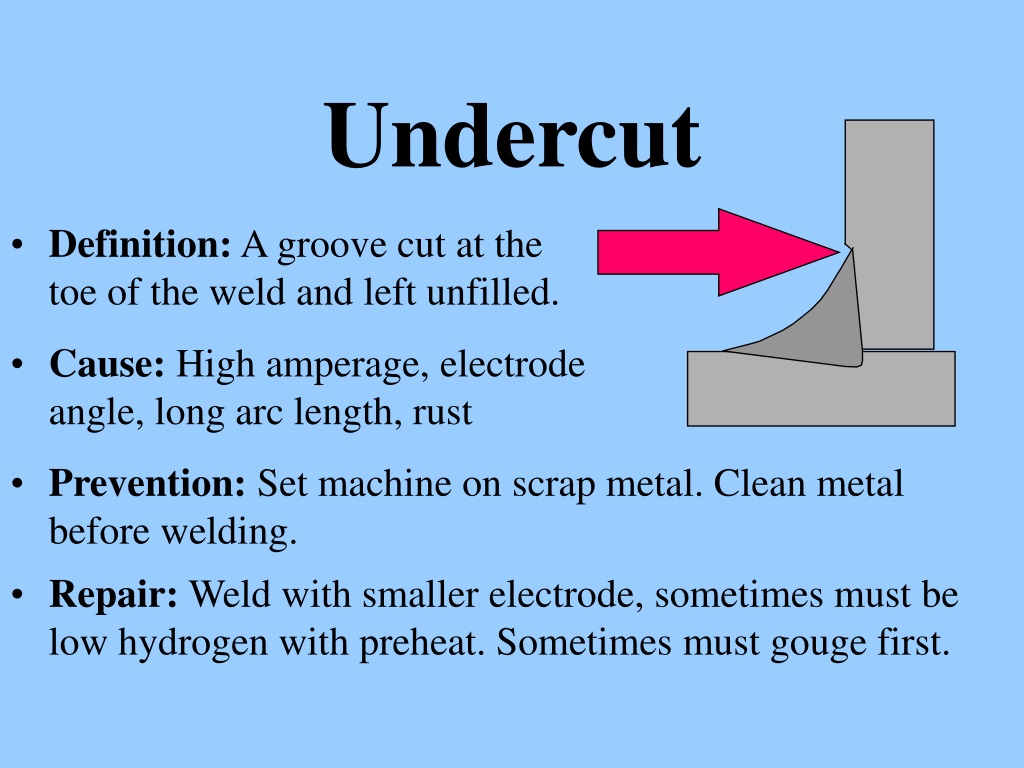Understanding the Causes and Solutions for Undercut Welding in Metal Construction Processes
In the realm of steel fabrication processes, the occurrence of undercut welding positions a considerable difficulty that demands an extensive understanding of its causes and practical services. The elaborate interplay of various factors throughout welding procedures can cause this unfavorable phenomenon, impacting the architectural stability and overall top quality of the bonded joints - Preventing weld undercut. By dissecting the root triggers of undercut welding and checking out efficient remedial measures, makers can boost the requirement of their workmanship and ensure the manufacturing of remarkable metal components
Usual Reasons For Undercut Welding
Frequently overlooked in steel construction, undercut welding occurs as a result of different factors that require careful attention and knowledge to be effectively minimized. One typical cause of undercut welding is extreme heat input. When the warmth input is too expensive, it can lead to the melting and succeeding erosion of the base product along the edges of the weld joint, producing a groove or undercut. Additionally, inappropriate welding techniques, such as making use of the wrong welding angle or take a trip speed, can likewise add to damage development. Insufficient securing gas protection is an additional essential variable that can result in damaging. Insufficient gas protection falls short to safeguard the weld swimming pool properly, leading to oxidation and undercut flaws. The choice of welding specifications, such as voltage, existing, and cord feed speed, plays a considerable duty in the event of undercut welding. Understanding these typical reasons is crucial for carrying out safety nets and guaranteeing high-grade welds in metal fabrication processes.
Effect of Incorrect Welding Parameters
Incorrect welding specifications can substantially jeopardize the stability and high quality of welded joints in metal fabrication processes. The impact of wrong welding criteria shows up in numerous methods, resulting in structural weaknesses and issues in the bonded elements. One vital element affected by improper welding parameters is the infiltration deepness of the weld. Not enough warmth input as a result of reduced welding currents or excessively high traveling rates can result in inadequate blend between the base metals, bring about insufficient joint penetration and damaged bonds. Alternatively, too much warm input triggered by high welding currents or slow-moving travel speeds can bring about burn-through and extreme support, producing a brittle and unpredictable weld framework. Furthermore, incorrect criteria such as improper voltage setups or incorrect electrode angles can add to unpredictable weld grain profiles, absence of fusion, and raised possibilities of defects like damaging. Therefore, careful attention to welding specifications is paramount to make sure the production of top notch welds with the desired mechanical residential or commercial properties and architectural integrity.
Result of Improper Torch Angle
Improper lantern angle in welding procedures can substantially affect the high quality and integrity of the last weld joints in steel construction processes. Damaging is an usual welding flaw where a groove develops along the weld toe, compromising the joint and compromising its architectural stability.
A lantern angle that is also steep can lead to not enough infiltration, incomplete fusion, and increased spatter. On the various other hand, a lantern angle that is too shallow can cause extreme penetration, burn-through, and distortion of the base product. Preventing weld undercut. Appropriate torch angle is essential for making certain regular weld high quality, strength, and look
To avoid undercutting and various other problems brought on by inappropriate torch angles, welders have to be educated to check my blog maintain the proper torch angle throughout the welding procedure. Routine monitoring and change of torch angles throughout welding can assist attain audio welds with minimal issues.
Function of Inadequate Welding Strategies

Another aspect of inadequate welding techniques is inappropriate weld prep work. Poor cleansing of the base metals, incorrect joint design, or insufficient side prep work can all add to undercut welding. Inadequate image source securing gas protection or utilizing the wrong kind of gas can result in insufficient combination and the formation of undercut defects.
To address the duty of insufficient welding techniques in steel construction processes, it is vital to give thorough training for welders. Appropriate education on welding criteria, joint preparation, and securing gas choice can help protect against undercut welding and make sure premium welds in steel construction projects.
Reliable Solutions for Undercut Welding
Dealing with undercut welding in steel construction requires carrying out effective remedies to improve weld top quality and structural honesty. One of the key options to combat undercut is to change welding parameters such as voltage, present, and take a trip speed to make certain proper warmth input and fusion. By fine-tuning these settings, welders can protect against extreme melting of the base steel and filler material, minimizing the likelihood of undercut formation.
In addition, proper joint preparation is critical in avoiding undercut. Making certain clean base metal surface areas cost-free of contaminants and utilizing the ideal bevel angle can help promote much better weld infiltration and reduce the danger of undercut - Preventing weld undercut. Using ideal welding techniques, helpful site such as oscillating the lantern or weaving, can additionally aid in distributing warm uniformly and loading the weld joint properly, lessening the opportunity of undercut issues
Furthermore, choosing the right welding consumables, consisting of electrodes and filler steels, is essential in reducing undercut. Utilizing products with ideal chemical compositions and mechanical residential properties can add to attaining audio welds with marginal undercut. Normal inspection and quality assurance measures should also be implemented to spot and deal with undercut issues quickly, guaranteeing the overall integrity of fabricated steel parts.

Verdict
In verdict, comprehending the causes and services for undercut welding in metal fabrication procedures is critical for attaining high-quality welds. By addressing usual reasons such as inaccurate welding specifications, improper lantern angle, and insufficient welding techniques, welders can prevent damaging and make sure strong, sturdy welds. It is necessary to take note of these elements and implement reliable services to improve the total welding process and end product top quality.
